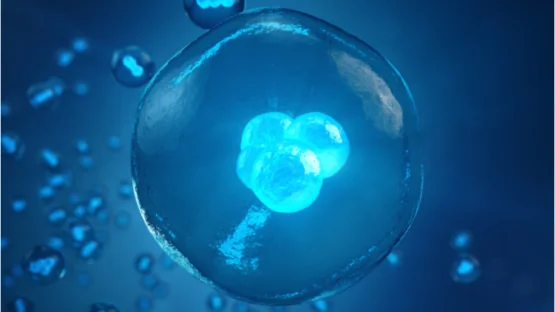A study conducted at the Institute of Reproductive Medicine in South Korea has shown that the protein expressed by growth-associated gene 6 (GAS6) ameliorates age-related decline in egg cells (oocytes).
A protein with many functions
Like many other proteins, the GAS6 protein serves multiple functions. It is associated with cellular proliferation, immunity, platelet activation, and cell survival; unfortunately, it also appears in diseases such as cancer [1]. In oocytes, a lack of this protein suppresses mitophagy and leads to mitochondrial dysfunction [2]. This data spurred the researchers of this study to further investigate its effects on egg cells.
Genomic and chromosomal effects
Introducing GAS6 into oocytes yielded significant results. Over 40% of aged oocytes without GAS6 were reported as having meiotic (division-related) defects; under 9% of the oocytes given GAS6 had such defects. Chromosomes, spindle, and overall genetic organization were also substantially improved in the GAS6 group.
A boost to mitochondria
Next, the researchers sought to determine how much the mitochondria in the oocytes were affected. The results here were equally impressive. Aged oocytes normally exhibit significantly reduced ATP, but oocytes given GAS6 had ATP levels similar to those of their young counterparts. The transcription of two critical mitochondrial DNA genes, Mtnd1 and Mtapt6, was increased with GAS6. Reactive oxygen species, normally increased in aged oocytes, were decreased with GAS6, which also increased the protective compound glutiathone.
Fertility improved
Finally, the researchers asked the most fundamental question regarding a cell: can it perform its function? In the case of oocytes, that function is fertility, and the differences were substantial. 53.3% of young oocytes were able to be fertilized, compared to 23.1% of aged oocytes; however, that number rose to 45% for aged oocytes given GAS6.
Abstract
Previously, we reported that the silencing of growth arrest-specific gene 6 (Gas6) expression in oocytes impairs cytoplasmic maturation by suppressing mitophagy and inducing mitochondrial dysfunction, resulting in fertilization failure. Here, we show that oocyte aging is accompanied by an increase in meiotic defects associated with chromosome misalignment and abnormal spindle organization. Intriguingly, decreased Gas6 mRNA and protein expression were observed in aged oocytes from older females. We further explored the effect of GAS6 on the quality and fertility of aged mouse oocytes using a GAS6 rescue analysis. After treatment with the GAS6 protein, aged oocytes matured normally to the meiosis II (MII) stage. Additionally, maternal age-related meiotic defects were reduced by GAS6 protein microinjection. Restoring GAS6 ameliorated the mitochondrial dysfunction induced by maternal aging. Ultimately, GAS6-rescued MII oocytes exhibited increased ATP levels, reduced ROS levels and elevated glutathione (GSH) levels, collectively indicating improved mitochondrial function in aged oocytes. Thus, the age-associated decrease in oocyte quality was prevented by restoring GAS6. Importantly, GAS6 protein microinjection in aged oocytes also rescued fertility. We conclude that GAS6 improves mitochondrial function to achieve sufficient cytoplasmic maturation and attenuates maternal age-related meiotic errors, thereby efficiently safeguarding oocyte quality and fertility.
Conclusion
Across-the-board improvements due to a single protein are rare, and it is clear that GAS6 has many downstream effects. The usual caveats apply; this was a cellular study and not conducted in living organisms, and these were mouse, not human, cells. However, the strength of these results has led the researchers to conclude that GAS6 is a potential target for future treatments and is definitely worth further investigation.
Literature
[1] Sasaki, T., Knyazev, P. G., Clout, N. J., Cheburkin, Y., Göhring, W., Ullrich, A., … & Hohenester, E. (2006). Structural basis for Gas6–Axl signalling. The EMBO journal, 25(1), 80-87.
[2] Kim, K. H., Kim, E. Y., Kim, Y., Kim, E., Lee, H. S., Yoon, S. Y., & Lee, K. A. (2011). Gas6 downregulation impaired cytoplasmic maturation and pronuclear formation independent to the MPF activity. PloS one, 6(8), e23304.




